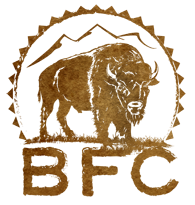Entering the road to Stephens Creek facility, the slight feeling of having done something illegal came to mind. During capture season there is a roughly seven mile closure along the western side of Old Yellowstone Trail from the town of Gardiner north to the border at Beattie Gulch. Having only seen the trap from afar through spotting scopes, entering the trap, on the bright yellow bus, felt uneasy.
The tour started off with a round of introductions. Montana Fish Wildlife and Parks, NPS and USFS personal from biologists to law enforcement were the largest presence. Others included members of various press agencies and two representatives from BFC. The short tour included a watered down version of the capture procedure as we walked along the endless maze of catwalks. The employees stay up on these catwalks during the capture process to "ensure personnel safety". Sadly, Yellowstone does not have the same measures in place to ensure safety of the buffalo they abuse. Walls of thick plywood and metal abound in a confusing array of holding pens, sorting pens and corrals terminating (no pun intended) at the squeeze shoot where, one by one, the buffalo are confined into the Silencer. Interestingly, Yellowstone has painted over “the Silencer” name of the squeeze chute, and in its place they have placed the years for that season’s operations. The squeeze chute is a tool of the livestock industry, its use is to render its victim immobile as various tests are conducted, keeping the humans in relative safety. From there they end up on cattle trailers, where after a last inspection, APHIS seals their fate as they latch an approved lock on the door, and then the trucks head to the slaughterhouse. Wild bison cannot be transported through the brucellosis Designated Surveillance Area (seven Montana counties close to Yellowstone’s borders) unless they are on their way to the slaughterhouse.
For our trip the trap was empty, except for 52 bull buffalo being held over for quarantine, 24 of whom have been behind fencing for almost two years. At the end of last year, there had been 59 bulls held captive for quarantine purposes, but we were informed that seven were dead; six had tested positive for brucellosis anti-bodies and were shipped to slaughter, the other bull died due to the trauma of human handling. The fact that they are all bulls should raise red alarms that they were slaughtered; bulls pose no risk of brucellosis transmission. And, never mind that Yellowstone’s 50-year quarantine plan has yet to be approved. This hasn’t stopped them from capturing for quarantine, nor building additional fencing in anticipation. The Park Service has updated their facilities by installing a second set of perimeter fencing of two corrals and have made upgrades to their water system in anticipation of approval of the quarantine facility. Though they are not an official quarantine site yet, a decision should be made any day now.
It was suggested that they are no longer slaughtering buffalo for disease management (which we’ve always known) but rather they are now in the business of population control of this last, remnant wild population. And of course, Yellowstone is ignoring their own warnings by carrying on with indiscriminate slaughter; they know members of the imperiled Central herd will undoubtably end up in the trap, destined for slaughter or domestication.
The tour ended with a Q+A session. One more trip on the bright yellow bus and our tour was over. The Park Service spokesperson who lead the tour put such a bright and cheery perspective on the whole thing, however we know better. And so do the buffalo.









